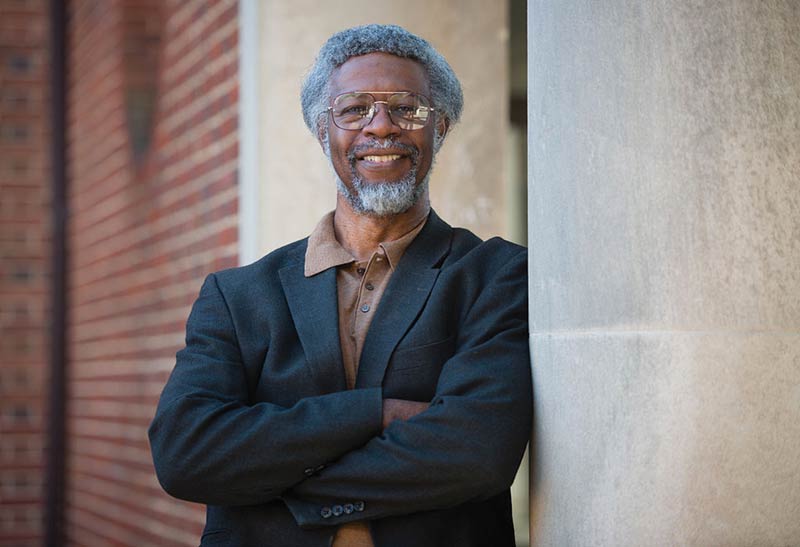by Rachel Kaufman

If we are living in the Matrix, Jim Gates will probably be the first one to figure it out.
The theoretical physicist, a professor at the University of Maryland and a visiting scholar at Dartmouth, has spent his entire career looking for supersymmetry. What that is is a concept tough for many to wrap their heads around, but it proposes that all particles have partners (that we haven’t discovered yet).
Along the way, Dr. Gates has gotten attention for discovering what he says is computer code in the math that underlies our world. (Specifically, he said it was an error-correcting mechanism; others have analogized this code to the checksums that make the Internet work.) This has led him to speculate--in a mostly-joking way--that we might in fact be living in a giant computer simulation.
What this would mean for our universe is not yet clear. But Gates is content to keep looking until he finds out.
Sylvester James Gates was born December 15, 1950 in Tampa, Florida.
At an early age he was fascinated by science. He cites books on space travel that his father bought him at age 8 as sparking his interest. “A world exploded in my head,” he said in 2013, “because I could see from these books that these tiny points of light in the sky at night were places you could go. And somehow in my young mind I knew that mathematics and science had something to do with going to those places.”
A bit character in an episode of the sitcom Make Room for Daddy opened his eyes to MIT. Gates told NOVA that seeing that show, portraying a smart kid who attended MIT, is “how I found out that there’s a place you can go to college where they only make you study the good stuff”—math, science, and engineering.
But at the same time, a potential disaster was mounting.
A few years prior to Gates discovering MIT, his father left the U.S. Army and moved to Orlando, Florida. At that time, the Army had integrated schools, but Orlando did not.
“I had to learn to be black,” he said in a 2013 speech.
“Segregation is an interesting phenomena to experience,” he said. “The people that are the minority come to believe the things that are said about them…One day on the playground…another African American said, ‘You’re pretty good at school.’ And I said, ‘Thank you.’ And he said, ‘But you can’t be as smart as a white guy.’”
When it came time to apply to college a few years later, “I understood lots of things about the rules of how our society worked in those days, and I thought there’s no way in the world that I would have the opportunity to go to such a place.” He would have stopped himself from applying—but his father “literally forced me to fill out the application form.”
Gates was accepted. At MIT he earned two degrees, a bachelors in math and one in physics, and went on to earn his Ph.D there four years later. His was the first written at MIT on supersymmetry, and no professors there could help him. Undaunted, he taught himself, earned his Ph.D., and moved on to Harvard.
After a number of prestigious research and teaching positions, Gates landed at the University of Maryland in 1984.
Since then, Gates has been plugging away at supersymmetry and string theory. His research has been recognized with the National Medal of Science and the Mendel Medal, and an appointment to President Obama’s President’s Council of Advisors on Science and Technology.
Do we yet know that string theory, or even just supersymmetry, is true? Not yet—and in fact, the first round of experiments at CERN’s Large Hadron Collider found no evidence of supersymmetry. But that’s just a push to keep going, Gates says.
“String theory is often criticized as having had no experimental input or output, so the analogy to a religion has been noted by a number of people,” Gates told NOVA. “In a sense that's right; it is kind of a church to which I belong. We have our own popes and House of Cardinals. But ultimately science is also an act of faith—faith that we will be capable of understanding the way the universe is put together.”
And if string theory is correct, so what? Well, Gates admits he doesn’t know. But think of the scientists like James Maxwell who unified electricity and mathematics. “One can imagine saying, ‘Professor Maxwell, what do your equations mean?’ He would struggle for answers. He would say, ‘Well, you know, the electric and magnetic phenomena are not separate, they're part of a unity.' But beyond that I think he would be rather hard-pressed to tell you what it means. One hundred and fifty years later we can answer this question very easily. A large fraction of our technological basis rests on his work.
"So if string theory is correct, what does it mean? Well, one can imagine 150 or 200 years from now some marvelous piece of technology that's beyond my imagining. Maybe it's a transporter from ‘Star Trek,’ perhaps it's warp drive, maybe our species finally is released from this prison of being contained in a single solar system.”
Until then, Gates will keep looking.
Also See:
Accessing My Creativity App, by Jim Gates (The SPS Observer, Winter 2015)